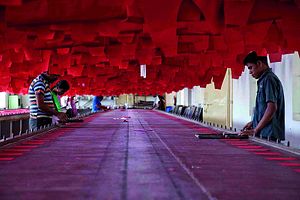In August of 2017, the Department of Industrial Policy and Promotion (DIPP) within the Ministry of Commerce and Industry, led by Suresh Prabhu, released a draft of the government’s new industrial policy. The policy would replace the industrial policy formulated in 1991, which was released during India’s balance of payments crisis, and before India liberalized its economy.
However, after multiple statements from the Commerce Minister that the policy will be released soon, it has not yet been announced publicly. With growing concerns of how India can create jobs, foster innovation and growth in its industries, and take advantage of emerging technology to fuel a new Industrial Revolution, the government should not delay further and publicly announce the policy.
This new industrial policy is slated to be a prominent policy articulation in India’s industrial policy after two previous such pivotal announcements in 1956 and 1991. The Industrial Policy Resolution of 1956 set the stage for state-owned and government-run enterprises, as well as establishing the a private sector that was regulated by a “system of licences.” It did so by dividing India’s industries into three categories.
The first category comprised of those industries in which the government was going to the primary actor and the exclusive actor, thereby setting a state monopoly in defense production, iron and steel production, electricity production and distribution, and mining. The second category included industries where the state would be primary actor in creating enterprises, but there was no state monopoly, and private actors could “supplement the effort of the state.” Only the third and final category would be open to private enterprise, but had to obtain a license from the government for standard business practices such as opening a new firm, or expanding production.
This policy came to a head in 1991, when India faced a severe economic crisis, leading to a shift away from the centrally-planned and socialist-based approach to the economy in the 1956 Industrial Policy, and towards a market-based economy. As a result, in 1991, the government passed a new Industrial Policy resolution that redefined the role of the government in industry, allowed private enterprises into industries they were previously barred from, and opened the economy to foreign investment.
While both policies have directed the state of India’s industrial growth for long swaths of time, neither is relevant for the economic growth and needs of India today, and a new policy is needed. Indeed, with emerging technologies creating new opportunities and industries for the future and concerns of jobs growing among India’s booming population, particularly the youth, an industrial policy crafted in the 20th century must be updated.
It was welcome, then, that in August 2017, DIPP released the draft of a new industrial policy aimed at fostering industrial growth in the 21st Century. In fact, the discussion paper from DIPP on the industrial policy itself articulated the need for an update, stating “It is time to shift from a policy of ‘continuity with change’ in 1991 to radical and accelerated reforms for greater strategic engagement with the world.” The draft policy focused on the creation of jobs, the promotion of foreign technology transfer, the growth of micro, small, and medium enterprises (MSMEs), and the establishment of a goal to attract $100 billion FDI annually.
While DIPP solicited public comments on the policy by September of 2017, it has not released a final draft of the policy to the public. Rather, there have been a series of announcements by Commerce Minister outlining a self imposed deadline that has been missed repeatedly.
The first of such deadlines came in November of 2017, when the Minister said the policy would be released “early next year.” In January, the timeline was pushed further when he said the policy would be released in the “next few months.” Then, in February, it was “in two months,” while by March, it was “next few weeks.” However, yet again in April, Minister Prabhu said “it will be released soon. As of this writing, the policy has not yet been released.
India’s industries sit at a critical time today, simultaneously facing numerous challenges and huge opportunities. In order to overcome the challenges and reap the benefits of these opportunities, however, India needs a new policy for the 21st century where India clearly outlines the role of industry in the nation’s strategy for growth. With rising concerns over the creation of jobs and the uncertainty of emerging technologies, a comprehensive policy articulation can set the agenda for Indian growth for the next decade. The Government of India should, therefore, not delay any further and articulate its vision for India’s industry by releasing the new Industrial Policy.

































